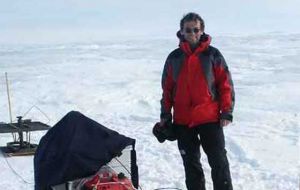MercoPress. South Atlantic News Agency
First complete map of Antarctica ice flow speed and direction
 “A game changer for glaciology” according to Eric Rignot from NASA’s Jet Propulsion Laboratory
“A game changer for glaciology” according to Eric Rignot from NASA’s Jet Propulsion Laboratory The first complete map of the speed and direction of ice flow in Antarctica will help scientists to track future sea-level increases, according to the team behind the project.
NASA-funded researchers this week revealed the map, which shows glaciers flowing thousands of miles from the continent’s deep interior to its coast. The team created the map using integrated radar observations from a consortium of international satellites.
“This is like seeing a map of all the oceans’ currents for the first time; it’s a game changer for glaciology. We are seeing amazing flows from the heart of the continent that had never been described before”, said Eric Rignot from NASA’s Jet Propulsion Laboratory:
A paper about the ice flow, along with the map, was published online Thursday in ‘Science Express’.
Rignot and University of California Irvine scientists Jeremie Mouginot and Bernd Scheuchl used billions of data points captured by European, Japanese and Canadian satellites to weed out cloud cover, solar glare and land features masking the glaciers.
With the aid of NASA technology, the team painstakingly pieced together the shape and velocity of glacial formations, including the previously uncharted East Antarctica, which comprises 77 percent of the continent.
Like viewing a completed jigsaw puzzle, the scientists were surprised when they stood back and took in the full picture. They discovered a new ridge splitting the 5.4 million-square-mile landmass from east to west.
The team also found unnamed formations moving up to 800 feet annually across immense plains sloping toward the Antarctic Ocean and in a different manner than past models of ice migration.
“The map points out something fundamentally new: that ice moves by slipping along the ground it rests on,” said Thomas Wagner, NASA’s cryospheric program scientist in Washington. “That’s critical knowledge for predicting future sea level rise. It means that if we lose ice at the coasts from the warming ocean, we open the tap to massive amounts of ice in the interior”.




Top Comments
Disclaimer & comment rules-

-

Read all comments”We are seeing amazing (ice) flows from the heart of the continent . . .
Aug 19th, 2011 - 08:04 pm 0formations moving up to 800 feet annually across immense plains sloping toward the Antarctic Ocean and in a different manner than past models of ice migration. . . . .
ice moves by slipping along the ground it rests on . . . . .
if we lose ice at the coasts from the warming ocean, we open the tap to massive amounts of ice in the interior”.
The speed that the **3 mile deep** ice mass of the interior moves to the coast is accelerating as the warming circum-polar waters (and, surprisingly, the Fukoshima earthquake) calve off the coastal ice.
This is a positive feedback system that we have virtually no chance of reversing.
Sea level rise is small, so far - but only at the moment.
The great sea-level cities of the world will need a bit of re-location because 'more than two-thirds of the world's large cities are in areas vulnerable to rising sea levels',
Scientists have always thought that the vast majority of ice contained in the Antarctic ice cap was formed from frozen precipitation. Recent research has revealed that this is not totally correct. Over a large fraction of East Antarctica, the deepest part of the ice sheet contains ice that did not originate as surface snow but developed when subglacial meltwater was frozen onto the underside of the ice sheet. The amount of ice involved is much larger than the estimated volume of Antarctic subglacial lakes and may even exceed the volume of all glaciers on Earth outside of the two polar ice sheets. Current computer models predict that subglacial water escapes toward the ocean. These new findings indicate that water from areas of basal melting actually migrate to areas of basal freezing, something not accounted for by current ice sheet models. To scientists' surprise, the East Antarctic Ice Sheet is getting thicker from the bottom up.
Aug 22nd, 2011 - 09:29 pm 0Commenting for this story is now closed.
If you have a Facebook account, become a fan and comment on our Facebook Page!